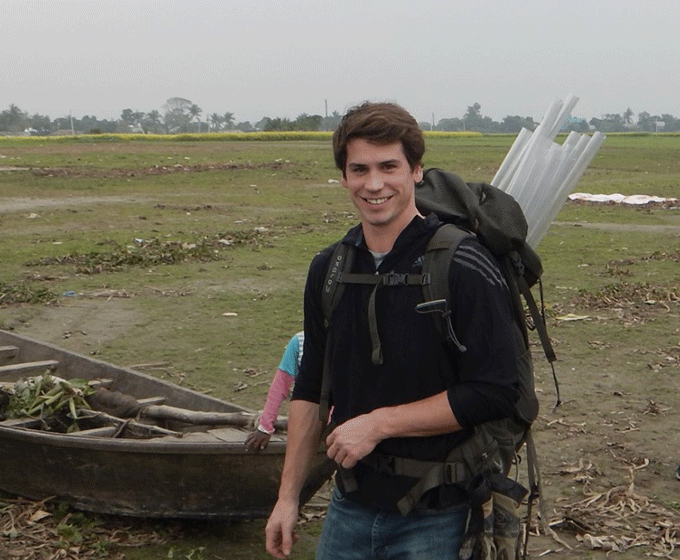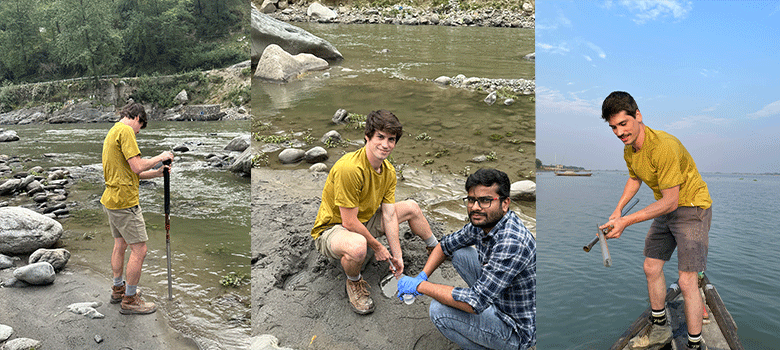
FEBRUARY 21, 2024 — From Bangladesh to India to Texas, Tom Varner is leveraging his research to improve sources for drinking water around the world.
Varner, a UTSA doctoral student in environmental science and engineering, explored the mobility of arsenic from the sediments surrounding the Meghna River in Bangladesh as part of a National Science Foundation-funded project.
The river flows through central Bangladesh, where elevated concentrations of arsenic in the groundwater threaten the welfare of millions of people. Long-term exposure to arsenic, which is toxic when ingested, can lead to cancer, epigenetic defects, vascular disease and other health ailments.

UTSA doctoral student Tom Varner is using his research to improve sources for drinking water around the world.
The project is a collaborative effort between researchers in the UTSA Department of Earth and Planetary Sciences, University Texas at Austin and Texas A&M University. Most recently, Varner traveled to India in spring 2023 to complete a Fulbright research project along the Hooghly River. The work complimented the work he did along the Meghna River in Bangladesh.
Varner is working under the mentorship of Saugata Datta, director of the UTSA Institute for Water Research, Sustainability and Policy. The graduate student’s work, which integrates aspects of science, engineering and public health to address water resources, carries significance outside the laboratory.
“This represents a new research topic for UTSA,” Datta, professor and chair in the UTSA Department of Earth and Planetary Sciences, said. “As part of the international scope of this research project, UTSA experiences a high level of interest from the international scientific community. Varner’s work has established the groundwork for many aspects in upcoming proposals, which once funded, confirm UTSA’s classification as an R1 university.”
Varner is investigating a phenomenon known as the Natural Reactive Barrier (NRB) along the Meghna River and Hooghly Rivers wherein the mixing of oxygen-rich river water and reducing groundwater in the riverbank facilitates the formation of iron-oxides, which can effectively remove the arsenic from the groundwater.
A robust understanding of this natural phenomena may be used to identify low arsenic groundwater zones along rivers where drinking wells may be safely installed and can be further extrapolated to understand the cycling of metals and contaminants along river corridors.
“Understanding more about these processes and the natural reactions that occur between the river and aquifer will provide the groundwork for future studies to understand how contaminants behave in the environment,” Varner said. “There are social benefits that can be applied as well; preventing exposure to arsenic in drinking water can help to improve the health of afflicted communities. The research also is relevant for environmental risk assessment and remediation projects dealing with groundwater contamination along river corridors.”
Although the study’s primary focus is within Bangladesh, Varner’s research provides insights into the universal processes regulating arsenic in groundwater. His work can be applied to further understand similar groundwater systems in local areas.
“For example, the iron-enriched sediments within the deltaic aquifers along the Brazos River in Texas and the nearby Mississippi River delta are also associated with elevated arsenic in the groundwater and parallel the conditions we have observed in Bangladesh,” Datta said.
Varner has produced six publications detailing the processes responsible for high and low arsenic concentrations along the Meghna and Hooghly Rivers. He’s also contributing two book chapters to the upcoming book titled “Advances in River Corridor Research and Applications,” detailing work along the Hooghly and Beas Rivers in India.
“UTSA has provided a great platform to jump out and do this research, from the financial support of grants from Dr. Datta and support from the EPS department to go to conferences. The Graduate School has provided support through various means, such as graduate student travel grants and award-based competitions such as the Transdisciplinary Team Grand Challenge. There’s always support there,” Varner said.
UTSA Today is produced by University Communications and Marketing, the official news source of The University of Texas at San Antonio. Send your feedback to news@utsa.edu. Keep up-to-date on UTSA news by visiting UTSA Today. Connect with UTSA online at Facebook, Twitter, Youtube and Instagram.
Move-in Day is an exciting time for incoming students. Students living in Chaparral Village move in from August 20-21. The UTSA Housing and Residence Life (HRL) team looks forward to welcoming you all and helping you settle into your room.
Chaparral VillageMove-in Day is an exciting time for incoming students. Students living in Laurel Village move in on August 22. The UTSA Housing and Residence Life (HRL) team looks forward to welcoming you all and helping you settle into your room.
Laurel VillageThe College of Sciences welcomes our newest Roadrunners to UTSA at VIVA Science! This interactive event connects students with faculty, staff, student leaders, and peers while highlighting the opportunities available across the College.
Outdoor Learning Environment 2 (OLE), Flawn Building, Main CampusWe're excited to welcome the new class of UTSA College of Liberal and Fine Arts (COLFA) students to campus! Move In To COLFA is strongly recommended for new students in COLFA because it gives you the chance to learn about the Student Success Center, learn how to do college successfully and meet new friends.
Galleria (MH 2.01), McKinney Humanities Building, Main CampusBuild connections with your Alvarez College of Business peers and learn more about the Career Compass program! This opportunity will provide fun interactions, giveaways and a chance to meet your next friend!
Richard Liu Auditorium (BB 2.01.02,) Business Building, Main CampusCelebrate the end of summer and the start off a great fall semester with The Housing Block Party! This event will have live music, carnival-style treats, artists, games, and activities galore. Come and join us for a night of fun!
Multipurpose Room/Lawn, Guadalupe Hall, Main CampusBe part of an unforgettable night as SOSA takes the field for its first public performance of the season! Experience the power, pride, and pageantry of UTSA’s marching band. Learn beloved traditions, practice cheers, and feel what it means to be a Roadrunner.
Campus Rec FieldsThe University of Texas at San Antonio is dedicated to the advancement of knowledge through research and discovery, teaching and learning, community engagement and public service. As an institution of access and excellence, UTSA embraces multicultural traditions and serves as a center for intellectual and creative resources as well as a catalyst for socioeconomic development and the commercialization of intellectual property - for Texas, the nation and the world.
To be a premier public research university, providing access to educational excellence and preparing citizen leaders for the global environment.
We encourage an environment of dialogue and discovery, where integrity, excellence, respect, collaboration and innovation are fostered.